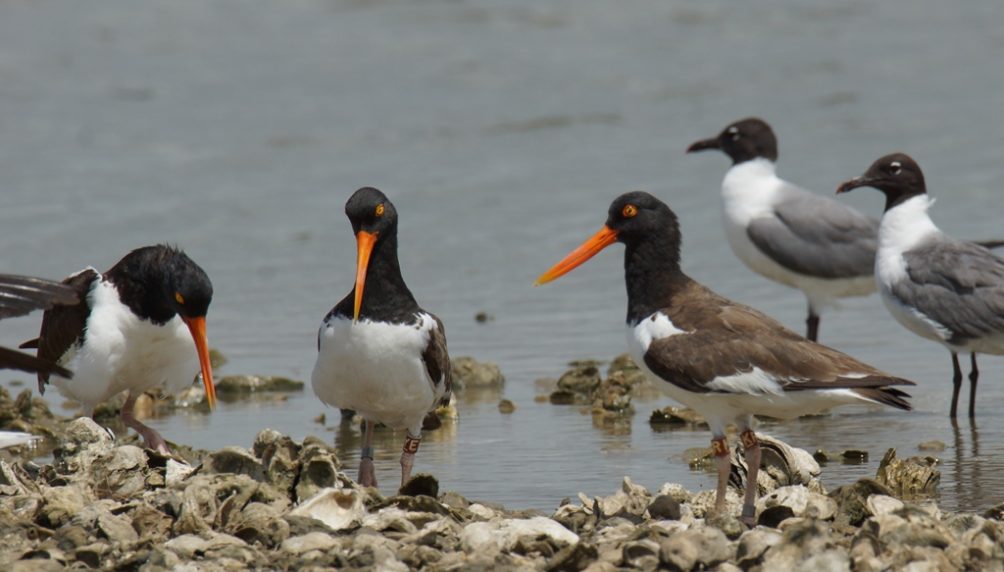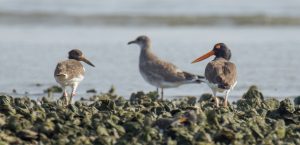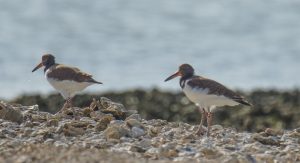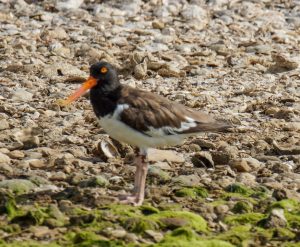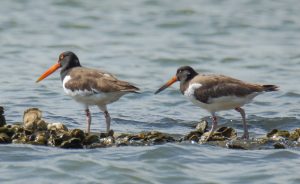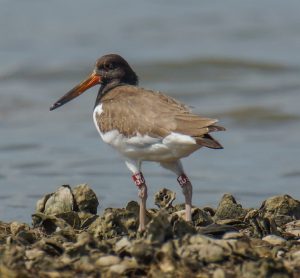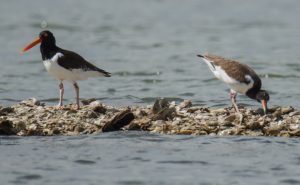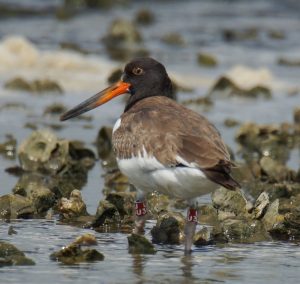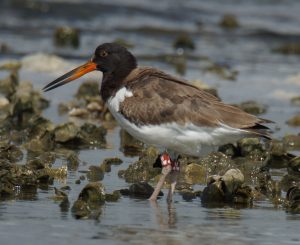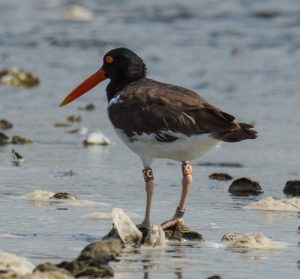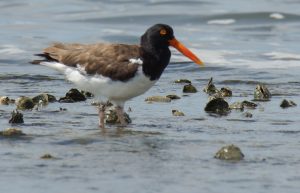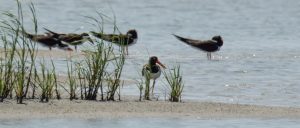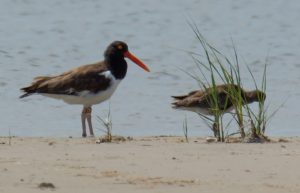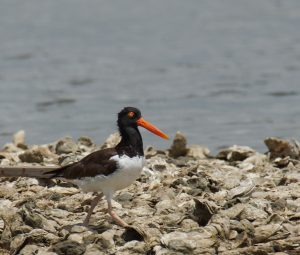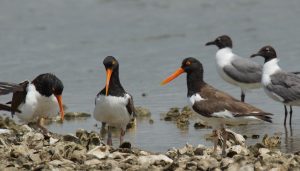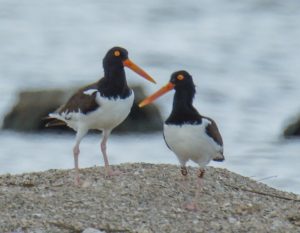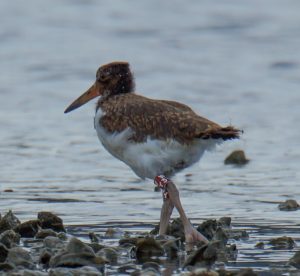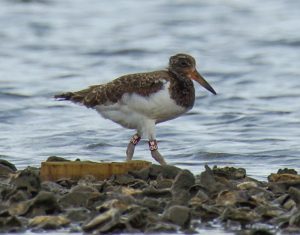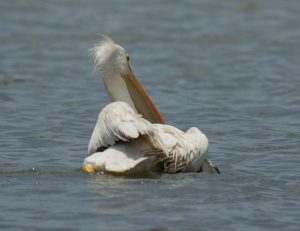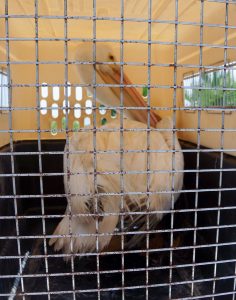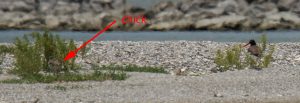By Susan Heath
It’s July and we are still monitoring oystercatchers! Most years they are done by the end of June but this year we have one last chick that won’t be fledged until late July so we’ll keep checking on everybody since we will be out there anyway. This late season monitoring will also help to make sure nobody is trying to sneak a chick past us.
I headed out to West Galveston Bay with Alan Wilde and Davis Clay on Tuesday. Alan and I had seen an injured American White Pelican in Swan Lake for the past two weeks so today Alan came prepared with Tim Long’s huge catching net and a kennel in case we could run it down. Since we wanted to do that last, we ran our usual route in reverse so we’d end at Swan Lake.
The tide was really low so there was lots of exposed reef. R3 & unbanded did us a favor by flying over to greet us when we left the boat ramp so we didn’t have to go looking for them and could head out to Jones Bay the back way avoiding the no wake zone around Tiki Island. We checked for FR(ed) but he wasn’t at home. I’ve been nervous about all the chicks we banded last week so I was very happy to see that little W4U and W4W were still with P3 & unbanded. They ran when we approached so I backed off. I had hoped to see them fly just so I’d know they could but if they can’t yet they should be on the cusp. Since the tide is so low they have lots of reef to run on so even if a boat gets too close they shouldn’t have any reason to swim to get away.
Next up was 28 & AP and their two chicks W4X and W4Y. We found them on a reef near their nesting territory and all was well with their chicks too. Woohoo! They also ran when we approached so we backed off and went down the GIWW to check on ET & A8A.
ET & A8A were standing on top of the small island where they had their last nest. If only we hadn’t had that one high tide a couple of weeks ago they might have been successful there.
We headed back down to Marker 52 and had to pass by 28 & AP and their chicks again in route to the other pairs there. This time both chicks flew to another reef in response to our approach. Yeah! We moved on but found only one oystercatcher on the whole of the island. That was JC standing by herself without her constant companion H0. Hum. I suspect all of them were out feasting away somewhere with the tide so low.
We went around to the backside of Marker 52 to check the reefs there and we found JJ feasting away. There was another bird that I suspect was H0 way off on the other side of the reef but we weren’t able to get close enough to tell. We opted not to go behind North Deer and instead checked the reefs along the GIWW on the way to South Deer. There we found an unbanded pair with an unbanded chick which I suspect is the pair from North Deer that we didn’t manage to band and their chick that could fly before we got around to catching it.
We also found U3W one of the Confederate Reef gang sleeping the day away on a reef. It woke up in response to our rude approach to get a photo. Then we found JN & UW and their chick W2X. We haven’t seen them in a while so it’s good to know all is well.
On South Deer HL & L4 and their chick W3U were way out on the end of their reef but the chick flew when we approached and the adults followed after calling to it to come back I suppose. All three flew in a circle and landed back at the other end of the reef. This time they stayed put and Alan got some photos.
Further around South Deer 13 & unbanded and their chick W2Y were out on a reef too. I guess their chick can fly well now and it seems to be getting the hang of feeding itself too!
We headed around to check on Y7 & unbanded and their chick W2U that we banded last week but no one was home. Where did they go? The chick would be able to fly by now but it would be unusual for them to wander far from home with a chick that was just learning to fly. They do travel around as a family for a while though and since the tide was so low hopefully that’s what they were doing. I was disappointed we didn’t get to see them so I could mark the chick as fledged, but we’ll be out there next week so we can check again. There was an unbanded chick of the year feeding near there and at first I thought maybe they’d had two and we didn’t realize it but this chick was too old to have been one of theirs.
We motored a little further around and found what we thought was LL feeding in his territory but he was too far for me to read the color bands through my binoculars. There weren’t any other oystercatchers on South Deer but I was hoping to find Y7 & unbanded and their chick on a reef nearby so we started checking them. Instead we found LL & unbanded and their chicks U3U and U4W.
That made us wonder who the bird was we’d seen in LL’s territory so headed back over there. It had moved a little farther out and I was able to read the color bands. It was XC a bird banded as a chick in 2013 that we haven’t seen breeding anywhere.
Y7 & unbanded still weren’t home so we headed over to Confederate Reef to check and see who was there. First we found XA who just happens to be XC’s sibling from 2013. Interesting that they are both hanging around the same area five years later. We also found the rest of the usual gang: E7, U3Y, and U1Y.
Over at Gangs Bayou A4A & unbanded were loafing on some of the oyster balls there while their chick W2W was walking along the shoreline. Maybe its feet aren’t tough enough yet to stand on those rough oyster balls. We also found A1A trying to hide behind a spartina patch.
Further on we found Y5 a bird banded as a chick in 2011. We’ve seen Y5 every year but never on a breeding territory. Perhaps it’s a male that hasn’t found an open territory yet or its breeding somewhere that we haven’t discovered yet. There was what I’m pretty sure was a Willet standing next to it impersonating an oystercatcher chick. At least I think that’s a Willet! Maybe Y5 pulled one over on us.
We went back one more time looking for Y7 & unbanded but they still weren’t there so we headed over to the Galveston shoreline to check on 16 & unbanded. We found them happily feeding on a reef so we headed to Jigsaw. Many of the tern and skimmer chicks have fledged so that island isn’t quite as crowded as it has been. The oystercatchers were all out on reef feeding but there was an extra bird and it wasn’t a chick. We watched as YE’s unbanded mate came running down the reef to where YE and the extra bird were.
A vocal battle ensued and the extra bird flew off down the reef to where LH & WW were.
Another vocal battle ensued but this time WW and the extra bird flew off in a wide arc over the bay and then landed way down at the other end of the island in T5 & T6’s territory. T5 & T6 were over on another reef and they made no attempt to run off the intruders. Alan’s photos revealed that the extra bird was KR, a female from a nearby island Struve Luci. She never laid a nest this season despite defending a territory with an unbanded bird so I guess she’s looking for something better. I hate to tell you KR but you’d do well to stay where you were. That is some prime nesting habitat! This year three pairs fledged four chicks from that island. She won’t find anything better than that.
We headed over to Struve to check out 12 & unbanded’s chicks that we banded last week. The adults were there standing guard and I mentioned to Alan that they must still have at least one chick or they wouldn’t have been giving us the evil eye like they were.
These chicks are excellent at staying out of sight but they’re getting bigger and thus harder to hide. We saw one chick head running down the island behind the berm so went around to the other side of the island. Then we saw two chick heads running down the island back on the other side of the berm where’d we just been! Well at least both of them are still there. We went back to where we started and then for some reason one of the adults ran out onto the reef and both chicks followed giving us a clear view. Alan was able to snap some great photos.
I’d been watching the railroad bridge and it had been up all morning but now that we were ready to head up that way, it was down of course. Alan suggested we might be able to get under it since the tide was so low so we motored over to check it out. It seemed iffy and the train was already crossing the bridge so we opted to wait and we were on our way soon enough.
We headed over towards Virginia Point and found YK on his reef alone as he has been every time we’ve seen him this season. There were two fishing boats near Zimmerman Point so we couldn’t get very close to 20 & unbanded’s territory but we didn’t’ see them there anyway. Then we headed to Malone to check on LR & unbanded’s chick, the last chick of the season. We didn’t see the adults on the front side of the island so I headed into a small bay that allows us to look at the backside. Both adults were there and so was the chick but it quickly ran and hid not allowing Alan to get a photo.
It was time to head into Swan Lake and see if we could catch the injured white pelican. The past two weeks it was hanging out alone on a reef in R5 & X3’s territory. Today much to our surprise we were greeted with this.
Forty-five white pelicans plus the injured bird off to the right. What the heck are all those white pelicans doing here in early July? Although there are a few white pelican breeding colonies in Texas they are far down the coast in the Laguna Madre. There are none on the central or upper coasts. I have no idea why they are here! At any rate, they all flew off when we approached to grab the injured one. It jumped in the water and started swimming out into the deep which is exactly what we wanted it to do.
Davis jumped off the boat and took up station on the reef so it wouldn’t swim back over there and I raced the boat over to where the pelican was with Alan manning Tim’s giant net. I didn’t get the boat quite close enough on the first pass and Alan couldn’t reach it despite the long handle on the net. The pelican circled around and I couldn’t turn the boat that sharply so we went out, made a wide turn and headed back for try number two. This time I aimed the boat right for the pelican so no matter which way it turned we’d be right on it and Alan was able to get the net over its head and the body followed. The bird was so big that Alan couldn’t scoop it up so he just maneuvered it over to the boat and I reached down and hefted it into the boat. It immediately emptied its stomach contents into the boat (yuck!) which is a defensive mechanism. Nice to know it had been getting some food even though it couldn’t fly. We went back over to where Davis was so he could help us get the bird into the kennel and Davis kindly scooped up the fish the pelican left for us and threw it overboard. That went much smoother than I expected!
We went back over to LR & unbanded and this time Alan was able to get a fuzzy photo of the chick.
We headed back down to West Galveston Bay and I suggested we make one more check on Y7 & unbanded so we headed back over to South Deer. Sadly they were still not present so we headed back to the boat ramp.
Current Stats for upper Texas coast from Dickinson Bay to East Matagorda Bay: 0 nests being incubated, 58 failed nests, 1 nest with unfledged chicks, 1 nest with undetermined status, 29 chicks fledged
This project is supported by the National Fish and Wildlife Foundation and several private donors. If you would like to contribute you can do that on our website by clicking here! All donations are tax deductible and GREATLY appreciated.
Note: All trapping and banding for this project is in accordance with federal and state permits issued to Susan Heath, GCBO Director of Conservation Research. Bird handling by volunteers is only permitted in the presence of Susan Heath and volunteers are trained in proper bird handling techniques.

